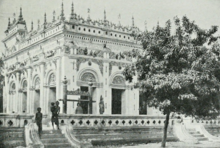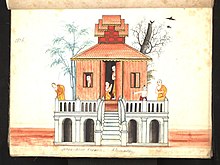Kyaung
Burmese kyaungs are sometimes also occupied by novice monks (samanera), lay attendants (kappiya), nuns (thilashin), and white-robed acolytes (ဖိုးသူတော် phothudaw).
According to 2016 statistics published by the State Sangha Maha Nayaka Committee, Myanmar is home to 62,649 kyaungs and 4,106 nunneries.
[7] In practice, from an architectural standpoint, there are 3 main types of monasteries:[7] In modern-day Myanmar, kyaungs may be divided into a number of categories, including monastic colleges called sathintaik (Burmese: စာသင်တိုက်; MLCTS: casang.tuik) and remote forest monasteries called tawya kyaung (Burmese: တောရကျောင်း; MLCTS: tau:ra.
[9] Classical learning was transmitted through monasteries, which served as venues for Burmese students to pursue higher education and further social advancement in the royal administration after disrobing.
[12] During the Konbaung Dynasty, various kings, including Bodawpaya suppressed the proliferation of pwe kyaung, which were seen as potential venues for rebellions.
[12] Sumptuary law dictated the construction and ornamentation of Burmese kyaungs, which were among the few building structures in pre-colonial Burma to possess elaborate multi-tiered roofs called pyatthat.




